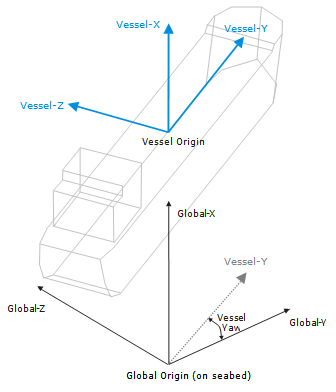▪X Coordinate (w.r.t. Mean Water Line)
▪Y Coordinate
▪Z Coordinate
▪Initial vessel yaw angle
These inputs completely describe the vessel configuration in its initial position. The vessel origin typically coincides with the centre of gravity of the vessel.
The vessel origin also represents the origin of the vessel axis system. The local X-axis is aligned with the global X-axis, the local Y-axis is aligned with the positive sense of the vessel’s surge axis, and the local Z-axis is aligned with the positive sense of the sway axis of the vessel. The surge axis of the vessel is obtained by rotating the global Y-axis in an anti-clockwise direction through the initial vessel yaw angle. Figure TN.4.1 shows the relationship between the local axis system of the vessel and the global axis system. All other locations specified on the Vessel component are with respect to these local axes.

Figure TN.4.1: Vessel Axis System
You can also define a vessel reference point. By default, the vessel reference point location is the same as the vessel origin. The vessel reference point is the point on the vessel for which the vessel RAOs are defined.
Vessel motions are specified for six vessel degrees of freedom, namely heave, surge, sway, yaw, roll and pitch. These degrees of freedom are defined in terms of a local vessel axis system, as shown in the figure below.

The local vessel x̂-axis corresponds to the heave direction, the local vessel ŷ-axis corresponds to the surge direction, and the local vessel ẑ-axis corresponds to the sway direction. The yaw, roll and pitch degrees of freedom correspond to rotations (in a right-handed sense) about the vessel heave, surge and sway axes, respectively.
The Stinger Origin, defined in terms of offsets from the Vessel Origin in the global axis system, is specified on the Vessel component as follows:
▪X Offset
▪Y Offset
▪Z Offset
▪Stinger Angle
This is generally any point that you choose on or in close proximity to the stinger. Exceptions to this are the hinged rigid S-Lay stingers, where it represents the start of the first stinger section, and J-Lay towers, where it represents the tower hinge point.
The stinger origin also represents the origin of the stinger axis system. The stinger-X axis corresponds to the vessel heave axis. The angle of the stinger Y-axis relative to the vessel surge axis depends on the stinger angle specified on the vessel, which defaults 180° (i.e. pointing in the aft direction). Figure TN.4.2 illustrates the stinger co-ordinate system relative to the vessel co-ordinate system. All other locations specified on the Stinger component are with respect to these local axes.

Figure TN.4.2: Stinger Axis System